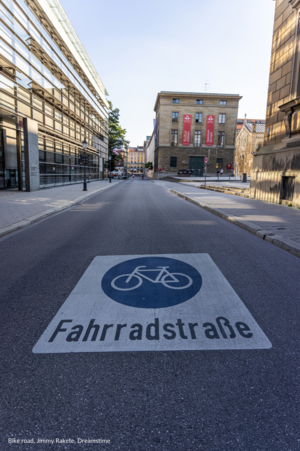Cycling Streets (Dreieich, Germany)

Area: town (40,000 inhabitants) within the Frankfurt Rhein Main Urban Area (2.3 million)
Date implemented: 2017
Relation between efforts undertaken and benefits achieved: The approach applied in Dreieich (and other German municipalities) is characterised by the implementation of relatively simple regulatory and physical measures. First, installation of the "Cycling Street" road sign gives priority to cyclists and sets a speet limit of 30 km/h (by German regulations). Next, the roadsurface width at the "entrance" to each section of the Cycling Street is reduced by arranging vegetation Third, "red carpets" and Cycling Street pictograms are painted on the roadsurface at intersections. No other modfications of the street layout is needed.
What was done and how: A series of "Cycling Streets" connects the centre of Dreieich-Buchschlag with the train station Dreieich-Buchschlag, which is one of the stops along the Frankfurt-Darmstadt route. The measure enables safe and quick commuting by combining cycling with public transport.
Why it worked to 'fast track' the innovation/measure: The relatively quick deployment of this innovative measure is the result of good stakeholder cooperation. It was developed by Dreieich's Cycling Round Table, which brings several local stakeholders together, including representatives from the political parties of the Local Council, the Vice-Mayor, the town's cycling advocate, a local representative of the German Cycling Association (ADFC), and staff from relevant offices of the local administration. After a decision by the Local Council, implementation went smoothly thanks to close cooperation between the different responsible offices, including the heritage protection office that argued against red street marking in an area characterised by historic villas. Residents were engaged during an evening event. Residents' advice was taken under consideration during the planning process. Not reducing the number of parking spots along the Cycling-Streets was one of the conditions stated by local political leaders taking needs expressed by residents into consideration.
Lessons learnt: Relatively simple regulatory and physical measures have the potential to significantly increase safety and comfort for active transport modes. Stakeholder and citizen engagement (here: Round Table, etc.) and give-and-take with locals increase acceptability of innovative solutions.
Tips for replication: It makes sense to integrate Cycling Streets into a regional cycling network. The Cycling Streets in Dreieich will, in the near future, be part of the Frankfurt-Darmstadt "Cycling Highway", which is currently under development.
Sources or links:
Date implemented: 2017
Relation between efforts undertaken and benefits achieved: The approach applied in Dreieich (and other German municipalities) is characterised by the implementation of relatively simple regulatory and physical measures. First, installation of the "Cycling Street" road sign gives priority to cyclists and sets a speet limit of 30 km/h (by German regulations). Next, the roadsurface width at the "entrance" to each section of the Cycling Street is reduced by arranging vegetation Third, "red carpets" and Cycling Street pictograms are painted on the roadsurface at intersections. No other modfications of the street layout is needed.
What was done and how: A series of "Cycling Streets" connects the centre of Dreieich-Buchschlag with the train station Dreieich-Buchschlag, which is one of the stops along the Frankfurt-Darmstadt route. The measure enables safe and quick commuting by combining cycling with public transport.
Why it worked to 'fast track' the innovation/measure: The relatively quick deployment of this innovative measure is the result of good stakeholder cooperation. It was developed by Dreieich's Cycling Round Table, which brings several local stakeholders together, including representatives from the political parties of the Local Council, the Vice-Mayor, the town's cycling advocate, a local representative of the German Cycling Association (ADFC), and staff from relevant offices of the local administration. After a decision by the Local Council, implementation went smoothly thanks to close cooperation between the different responsible offices, including the heritage protection office that argued against red street marking in an area characterised by historic villas. Residents were engaged during an evening event. Residents' advice was taken under consideration during the planning process. Not reducing the number of parking spots along the Cycling-Streets was one of the conditions stated by local political leaders taking needs expressed by residents into consideration.
Lessons learnt: Relatively simple regulatory and physical measures have the potential to significantly increase safety and comfort for active transport modes. Stakeholder and citizen engagement (here: Round Table, etc.) and give-and-take with locals increase acceptability of innovative solutions.
Tips for replication: It makes sense to integrate Cycling Streets into a regional cycling network. The Cycling Streets in Dreieich will, in the near future, be part of the Frankfurt-Darmstadt "Cycling Highway", which is currently under development.
Sources or links:






